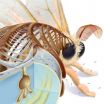(Press-News.org) ANN ARBOR, Mich.---By mimicking the structure of the silk moth's antenna, University of Michigan researchers led the development of a better nanopore---a tiny tunnel-shaped tool that could advance understanding of a class of neurodegenerative diseases that includes Alzheimer's.
A paper on the work is newly published online in Nature Nanotechnology. This project is headed by Michael Mayer, an associate professor in the U-M departments of Biomedical Engineering and Chemical Engineering. Also collaborating are Jerry Yang, an associate professor at the University of California, San Diego and Jiali Li, an associate professor at the University of Arkansas.
Nanopores---essentially holes drilled in a silicon chip---are miniscule measurement devices that enable the study of single molecules or proteins. Even today's best nanopores clog easily, so the technology hasn't been widely adopted in the lab. Improved versions are expected to be major boons for faster, cheaper DNA sequencing and protein analysis.
The team engineered an oily coating that traps and smoothly transports molecules of interest through nanopores. The coating also allows researchers to adjust the size of the pore with close-to-atomic precision.
"What this gives us is an improved tool to characterize biomolecules," Mayer said. "It allows us to gain understanding about their size, charge, shape, concentration and the speed at which they assemble. This could help us possibly diagnose and understand what is going wrong in a category of neurodegenerative disease that includes Parkinson's, Huntington's and Alzheimer's."
Mayer's "fluid lipid bilayer" resembles a coating on the male silk moth's antenna that helps it smell nearby female moths. The coating catches pheromone molecules in the air and carries them through nanotunnels in the exoskeleton to nerve cells that send a message to the bug's brain.
"These pheromones are lipophilic. They like to bind to lipids, or fat-like materials. So they get trapped and concentrated on the surface of this lipid layer in the silk moth. The layer greases the movement of the pheromones to the place where they need to be. Our new coating serves the same purpose," Mayer said.
One of Mayer's main research tracks is to study proteins called amyloid-beta peptides that are thought to coagulate into fibers that affect the brain in Alzheimer's. He is interested in studying the size and shape of these fibers and how they form.
"Existing techniques don't allow you to monitor the process very well. We wanted to see the clumping of these peptides using nanopores, but every time we tried it, the pores clogged up," Mayer said. "Then we made this coating, and now our idea works."
To use nanopores in experiments, researchers position the pore-pricked chip between two chambers of saltwater. They drop the molecules of interest into one of the chambers and send an electric current through the pore. As each molecule or protein passes through the pore, it changes the pore's electrical resistance. The amount of change observed tells the researchers valuable information about the molecule's size, electrical charge and shape.
Due to their small footprint and low power requirements, nanopores could also be used to detect biological warfare agents.
A research highlight on this work will appear in an upcoming edition of Nature. The paper is titled "Controlling protein translocation through nanopores with bio-inspired fluid walls."
INFORMATION:
This research is funded by the National Science Foundation, the National Institutes of Health, the Alzheimer's Disease Research Center, the Alzheimer's Association and the National Human Genome Research Institute. The university is pursuing patent protection for the intellectual property, and is seeking commercialization partners to help bring the technology to market.
For more information:
Michael Mayer: http://biomembrane.engin.umich.edu/
Abstract of article: http://www.nature.com/nnano/journal/vaop/ncurrent/full/nnano.2011.12.html
Michigan Engineering:
The University of Michigan College of Engineering is ranked among the top engineering schools in the country. At $180 million annually, its engineering research budget is one of largest of any public university. Michigan Engineering is home to 11 academic departments, numerous research centers and expansive entrepreneurial programs. The College plays a leading role in the Michigan Memorial Phoenix Energy Institute and hosts the world-class Lurie Nanofabrication Facility. Michigan Engineering's premier scholarship, international scale and multidisciplinary scope combine to create The Michigan Difference. Find out more at http://www.engin.umich.edu/
Silk moth's antenna inspires new nanotech tool with applications in Alzheimer's research
2011-03-01
ELSE PRESS RELEASES FROM THIS DATE:
Neighborhood barbers can influence black men to seek blood-pressure treatment
2011-03-01
DALLAS – March 1, 2011 – Will Marshall saw a physician about his blood pressure at his barber's urging.
Yes, his barber.
"The barber and beauty shops for men and women are kind of their own private escapes," Mr. Marshall said. "Every conversation you can imagine goes on in the barbershop. I wouldn't have put the barbershop and blood pressure together – but that visit to my physician for my blood pressure saved my life."
Mr. Marshall now has a healthy blood pressure thanks to lifestyle and dietary changes.
He is one of about 1,300 participants in a study described ...
Researchers looking at a rare disease make breakthrough that could benefit everyone
2011-03-01
This release is available in French.
MONTREAL, March 1, 2011 – By working with Canadians of French ancestry who suffer a rare genetic disease, researchers have discovered how three genes contribute to abnormal growth, making a breakthrough that will improve our understanding of many disorders such as foetal and childhood growth retardation, abnormal development of body parts and cancer. "As a result of the Human Genome Project, we know the basic identity of essentially all the genes in the human body, but we don't automatically know what they do in detail," explained ...
Quality of life significantly increases after uterine fibroid treatment
2011-03-01
OAK BROOK, Ill. – Women who received one of three treatments for uterine fibroids at Brigham and Women's Hospital in Boston said their symptoms diminished and their quality of life significantly increased, according to a new study published in the May issue of Radiology.
Uterine fibroids are benign pelvic tumors that occur in as many as one in five women during their childbearing years. Although not all fibroids cause symptoms, some women experience heavy bleeding, pain and infertility. Treatment options include hysterectomy, minimally invasive uterine artery embolization ...
Hospital use of virtual colonoscopy is on the rise, study suggests
2011-03-01
Reston, VA (Feb. 23, 2011) — Despite the absence of Medicare coverage, hospital use of computed tomographic colonography (CTC), commonly referred to as virtual colonoscopy, is on the rise, according to a study in the March issue of the Journal of the American College of Radiology (www.jacr.org). Colorectal cancer is the second leading cause of cancer deaths in the U.S. CTC, a minimally invasive alternative to optical colonoscopy for colorectal cancer screening, employs virtual reality technology to produce a 3-D visualization that permits a thorough evaluation of the entire ...
Is March Madness always the same?
2011-03-01
DURHAM, N.C. – Why is it that the same teams seem to dominate the annual men's collegiate basketball tournament? For that matter, why does the same small group of institutions seem to top annual best-college rankings?
According to a theory developed by a Duke University engineer, these hierarchies are not only natural, but predictable. Just as continually growing streams flow into a larger river, or smaller and smaller branches grow out from a single tree trunk, examples of these hierarchies abound in the natural world.
Whether it is a river or basketball rankings, ...
Effects of depression on quality of life improvement after endoscopic sinus surgery
2011-03-01
Alexandria, VA — Depression is a common problem in patients with chronic rhinosinusitis (CRS) and negatively impacts patients' symptom burden, ability to function, and quality of life (QOL), according to new research published in the March 2011 issue of Otolaryngology – Head and Neck Surgery.
Nearly 14 percent of Americans suffer from chronic sinusitis and may have the following symptoms for 12 weeks or more; facial pain/pressure, facial congestion/fullness, nasal obstruction/blockage, thick nasal discharge/discolored post-nasal drainage, and periodic high fever. If ...
Diversifying crops may protect yields against a more variable climate
2011-03-01
A survey of how farmers could protect themselves by growing a greater diversity of crops, published in the March issue of BioScience, has highlighted economical steps that farmers could take to minimize the threat to crops from global climate change, including a greater frequency of extreme climate events.
Adaptation to ongoing climate change is considered a policy priority for agriculture. The survey, by Brenda B. Lin of the Australian Commonwealth Scientific and Industrial Research Organization, documents multiple instances of farmers protecting economically important ...
Depressing future for men?
2011-03-01
Emory University experts predict that rates of depressive disorders among men will increase as the 21st century progresses.
In an editorial published in the March, 2011 issue of the British Journal of Psychiatry http://bjp.rcpsych.org/, author Boadie Dunlop, MD, writes "Compared to women, many men attach a great importance to their roles as providers and protectors of their families. Failure to fulfill the role of breadwinner is associated with greater depression and marital conflict."
Research shows that since the beginning of the recession in 2007, roughly 75 percent ...
Journal 'Chest': News briefs from the March 2011 issue
2011-03-01
SMOKING CESSATION HIGHER WITH VARENICLINE COMPARED WITH PLACEBO IN PATIENTS WITH COPD
New research shows that patients with chronic obstructive pulmonary disease (COPD) have higher smoking cessation rates with varenicline compared with placebo. In a multinational study involving 27 centers, researchers from UCLA followed 504 patients with mild to moderate COPD who were randomized to receive either varenicline (N=250) or placebo (N=254). At weeks 9-12, abstinence rates for patients treated with varenicline were higher than for the placebo group (42.3 percent vs 8.8 percent), ...
Watchful waiting no longer recommended for some high-risk Barrett's esophagus patients
2011-03-01
Bethesda, MD (March 1, 2011) — Endoscopic removal of pre-cancerous cells in patients with confirmed, high-risk Barrett's esophagus is recommended rather than surveillance, according to a new "Medical Position Statement on the Management of Barrett's Esophagus," published by the American Gastroenterological Association (AGA) Institute. The medical position statement was published in Gastroenterology, the official journal of the AGA Institute.
In patients with Barrett's esophagus, the normal cells lining the esophagus are replaced with tissue that is similar to the lining ...


